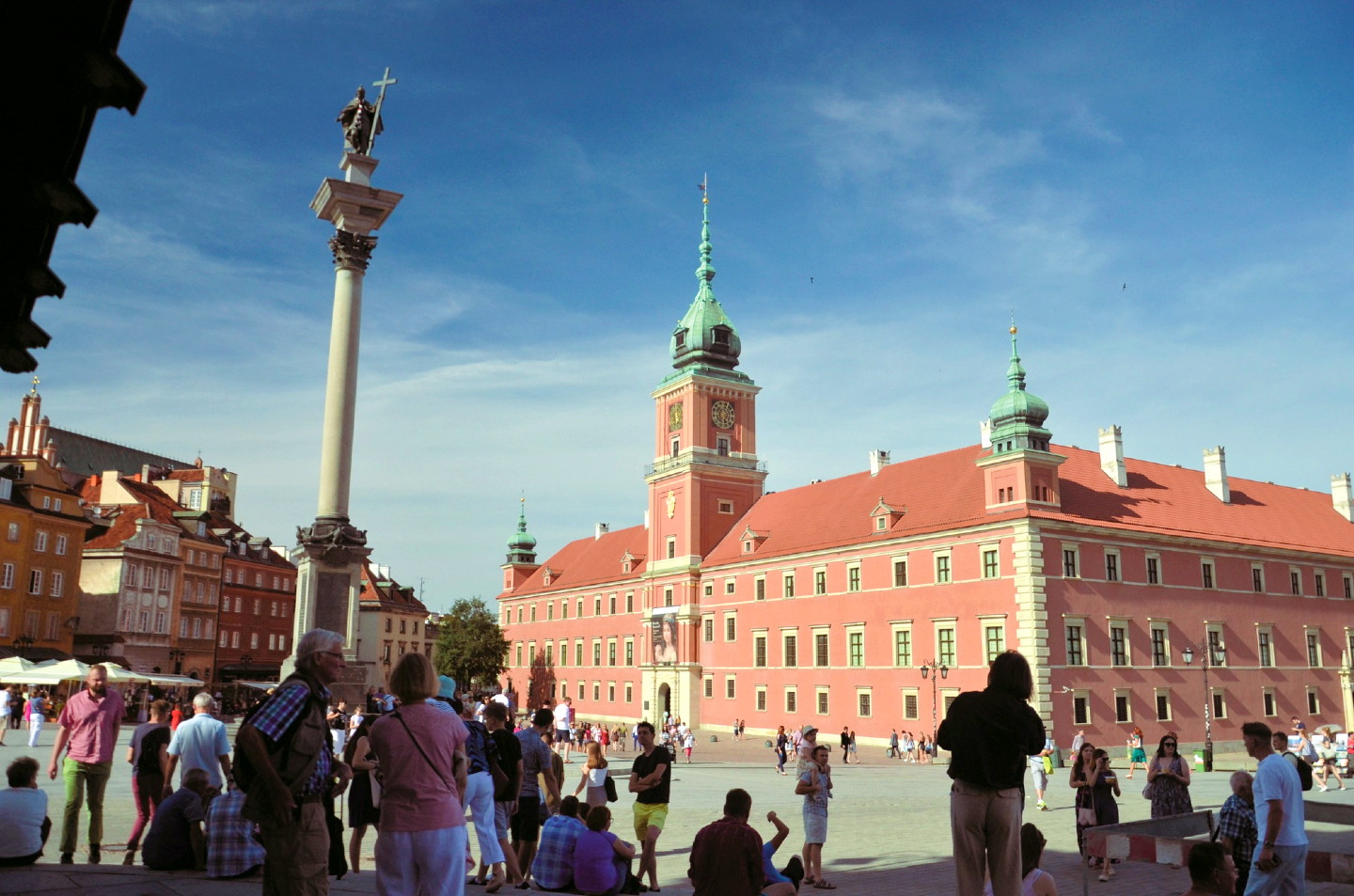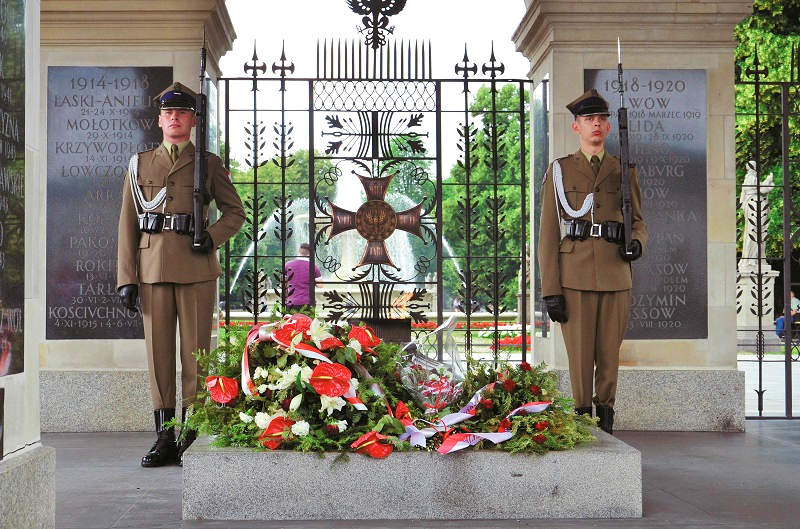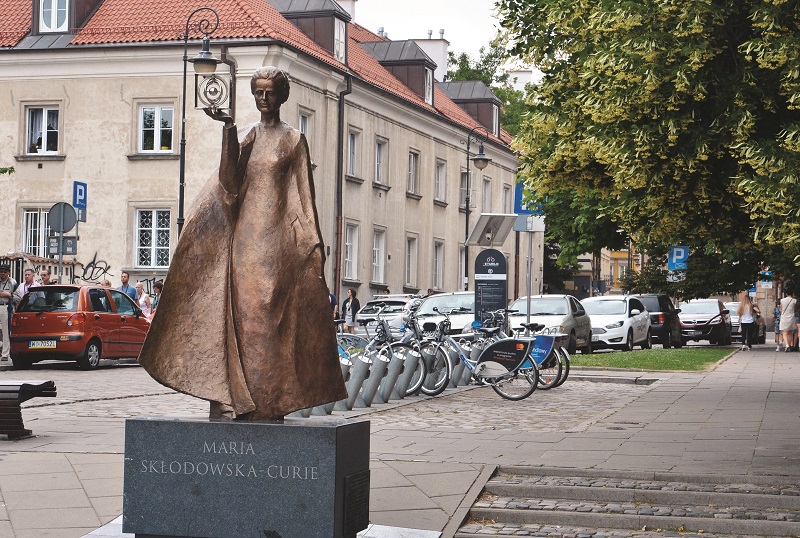
Sigismund’s Column and the Royal Castle are the main attractions at Castle Square (All photos: Lee Yu Kit)
In Warsaw, there is a palm tree — the only one in the city — in the middle of the Charles de Gaulle roundabout, a small and busy traffic circle in the centre of the city. A statue of Charles de Gaulle, showing the one-time president of France striding confidently, stands atop a pedestal on a nearby sidewalk.
Not unexpectedly, the palm is made of plastic — a piece of lighthearted kitsch in a city with a history almost too heavy to bear. It is located along the Royal Route, a historical road linking three royal residences and now one of the main thoroughfares of Warsaw, with many noteworthy attractions.
North of the palm tree is a section of the Royal Route called Nowy Swiat, a broad swathe of road with sidewalk cafés, restaurants, gelato stalls, boutiques and shops on both sides. Closed to vehicular traffic on weekends, it sees a constant stream of people walking and tourists cycling.
palm.jpg

Further up, the road’s character and identity changes upon assuming the tongue-twisting name of Krakowskie Przedmieście. Lining the road are fine and aristocratic buildings, including the posh Hotel Bristol that has hosted presidents, royals and luminaries such as Richard Nixon, John F Kennedy, Tina Turner and Depeche Mode.
Located nearby is the Nicolaus Copernicus Monument, dedicated to the astronomer who established that the sun, and not the earth, is at the centre of the known universe. A little further on, set back a short distance from the road, is the 17th century classical-looking Presidential Palace, where the Polish president resides.
Across the road, the baroque architecture of the Roman Catholic Church of the Holy Cross invites visitors into its cavernous interior, where the observant will notice a plaque set into a column of the church. This is where the heart of one of Warsaw’s most famous sons, the great composer Frédéric Chopin, is kept, although his body is buried in Paris, France.
A diversion of a few hundred metres away leads to a lush park with mature trees and fountains. In front of the park is a small marble pavilion where two soldiers with steely bayonets mounted on their rifles stand guard over the eternal flame of the Tomb of the Unknown Soldier.
tomb.jpg

Back on Krakowskie Przedmieście, the road leads to the open expanse of Castle Square, the best-known square in Warsaw. It derives its name from the imposing Royal Castle, which occupies an entire side of the square. Castle Square marks one end of the Royal Route and the beginning of Warsaw’s Old Town, a Unesco World Heritage Site.
Sigismund’s Column, on which a statue of the king who made Warsaw the capital of Poland in 1596 is mounted, rises from the square. Pedestrian alleys lead away into the narrow, cobbled streets of Old Town, hemmed in by tall, narrow buildings on either side.
Churches, restaurants, cafés and shops, many of them catering for the tourist industry, occupy the buildings. A decorated door frame, a sundial mounted on the side of a building, a statue protruding from a corner, flowers on a windowsill — these are some of the eye-catching details of Old Town. It is said that the number of windows in a building informs one about the owner’s social status and wealth.
The street opens up into Market Square. This was the main square of Warsaw in the 13th century, now crowded with tourists, outdoor cafés and stage shows. During the 13th century, it would have been unpaved and busy with the noises, sights and smells of produce and goods being traded at an outdoor market. At the centre of the square is a statue of the Mermaid who wields a sword, for she is the guardian of the city and features prominently on Warsaw’s coat of arms.
houses.jpg

Old Town, though, is not what it seems — as charmingly medieval as it appears, it was actually reconstructed in modern times. The original Old Town was almost completely destroyed during World War Two. In 1944, Polish resistance fighters rose up against the Nazis in what is known as the Warsaw Uprising. The conflict lasted two months and was bloody and one-sided, with an estimated 150,000 to 200,000 Polish and some 20,000 German casualties. Ultimately, the uprising failed in its objective to oust the Nazis.
Retribution was swift and terrible, with Nazi demolition squads deliberately razing the historic centre of Warsaw. Churches, residences and historic buildings were destroyed with explosives and flamethrowers. Thousands of holes were drilled into the walls of the Royal Castle, filled with explosives and detonated, reducing the centuries-old building into a pile of rubble. It is estimated that over 85% of Old Town was destroyed.
All that remained were basements and sections of walls, with post-war pictures depicting an apocalyptic scene of destruction. Astonishingly, after the war, the country decided to reconstruct the historic heart of Warsaw. The rebuilding was funded by a national fundraising campaign, with money donated by Poles who lived abroad and those in Poland who contributed what they could.
So much of the Old Town was destroyed that architects and planners had to refer to 18th century cityscape paintings of Warsaw by Italian painter Bernardo Bellotto (1722-1780) for the reconstruction. His paintings, commissioned by the king of Poland, were painstaking in detail and they can be seen today in the Royal Castle Museum. Reproductions are mounted on street information boards in Old Town.
A substantial amount of the reconstruction was completed by the 1960s, although rehabilitation continued for years afterwards. The reconstruction of the Royal Castle was only completed in 1984.
Walking deeper into Old Town brings the visitor to the Barbican, a fortified outpost, beyond which is the modest house where Marie Curie (1867-1934) was born. She won the Nobel Prize — twice — for her discoveries in radioactivity.
curie.jpg

Further on, the Old Town ends with a statue of Marie Curie overlooking a water park. Beyond that are a modern highway and the broad expanse of the green Vistula River, which cuts across Warsaw.
The nearby riverbank has been beautified with artificial beaches, restaurants and cafés, plants and a walkway. Social gatherings as well as outdoor and sport events are often held by the river, where people can take in the soothing expanse of water with the city as a backdrop. The river itself is a venue for water sports such as canoeing and swimming.
The far bank of the Vistula River has been left in its natural state, with sandy beaches, shrubbery and verdure and the wildlife they support — waterfowl and small mammals. This patch of wilderness is where families come in the evenings for picnics, gatherings, barbecues and games.
Further down the river, the skyline is dominated by the PGE Narodowy Stadium, built for the 2012 European Football Championship, with a seating capacity of 58,000.
There is plenty of evidence of Warsaw’s fondness for Chopin (1810-1849), who spent half his life in the city. Multimedia benches in Old Town mark sites significant to the life of the composer, and with the press of a button, a piece of his music is played. Many concert halls in the city hold recitals of Chopin’s music, but if you are visiting during the summer, the place to go for sheer atmosphere is the free concert held every Sunday at noon and 4pm in the Łazienki Royal Park.
music.jpg

The park comprises 76ha of woodlands in the heart of the city and is on the Royal Route, in the opposite direction from Nowy Swiat. Tall trees, shrubbery and lawns provide a green oasis, a change from the noise and bustle of the city and a place to come to for contemplative quiet and rejuvenation. There are water features in the park as well, notably a lake, in the centre of which is the Palace on the Island. The residence of Poland’s last king, it is considered a gem of Polish architecture and now houses a museum.
Also in the park is the Chopin Monument, a larger-than-life statue of the composer under a willow tree. Destroyed by the Germans during World War Two, it was rebuilt after the war. In the summer, hundreds, if not thousands, of the city’s residents turn up to listen to his music, played from a small tent erected next to the monument. Families with children, couples, singles, the old and the young lounge on the grass in the shade of trees or sit on park benches by the flower beds to listen in rapt silence to the piano music wafting in the summer breeze.
There does not seem to be a better remedy for Warsaw’s history than this — indulging in high culture while surrounded by verdure in the middle of the city, with music in the air and sunlight filtering through the canopy above replacing the hopeless desolate wasteland of war, destruction and oppression less than a century ago; the inflicted damage on a country’s heritage and identity, reclaimed and reborn, on a balmy afternoon.
This article first appeared on Sept 9, 2019 in The Edge Malaysia.


